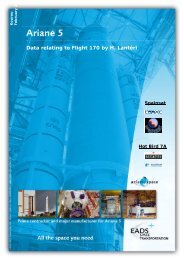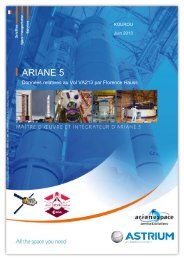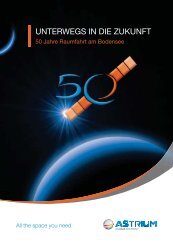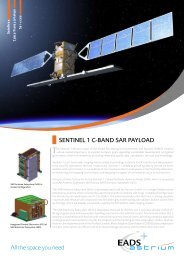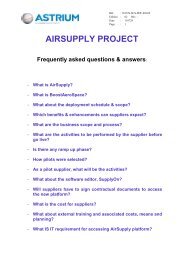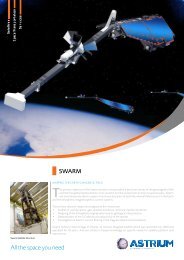lisa pathfinder All the space you need - Astrium - Eads
lisa pathfinder All the space you need - Astrium - Eads
lisa pathfinder All the space you need - Astrium - Eads
You also want an ePaper? Increase the reach of your titles
YUMPU automatically turns print PDFs into web optimized ePapers that Google loves.
<strong>lisa</strong><br />
<strong>All</strong> <strong>the</strong> <strong>space</strong> <strong>you</strong> <strong>need</strong><br />
<strong>lisa</strong> <strong>pathfinder</strong><br />
The LISA Pathfinder mission is a technology demonstrator mission that will test a series of ultra-high<br />
precision technologies to be used on a later, and much larger, international project LISA (Laser Interferometric<br />
Space Antenna), for which <strong>the</strong> European Space Agency is preparing a leading European role.<br />
LISA Pathfinder will carry out in-orbit testing of <strong>the</strong>se key technologies including <strong>the</strong> micro-propulsion systems,<br />
<strong>the</strong> drag-free control systems and <strong>the</strong> technologies associated with <strong>the</strong> payload. There are two payload test<br />
packages, one from ESA funded by national institutes and universities and drawn toge<strong>the</strong>r under <strong>the</strong> auspices<br />
of <strong>Astrium</strong> GmbH as <strong>the</strong> LTP architect, whilst <strong>the</strong> second payload is provided by NASA.<br />
The primary LISA mission will measure gravitational waves generated by exotic cosmic events such as collapsing<br />
binary star systems and <strong>the</strong> collision of massive black holes. Through LISA Pathfinder, EADS <strong>Astrium</strong> will<br />
augment its proven capability in astronomy and planetary exploration by development of <strong>the</strong> know-how for<br />
<strong>space</strong>-based fundamental physics exploration.
7321tl oct 08 © <strong>Astrium</strong>, images © <strong>Astrium</strong><br />
Customer European Space Agency<br />
Mission Technology demonstration for <strong>the</strong> future LISA mission – to detect relative<br />
movement of two solid bodies freely floating in <strong>space</strong> with accuracy of<br />
10 picometers<br />
Orbit 500 000 x 800 000km Halo orbit around L1<br />
Spacecraft • Spacecraft mass: 450kg<br />
• Propulsion module including fuel: 1420kg<br />
Payload • The LISA Test Package (LTP)<br />
• The Disturbance Reduction System (DRS) from JPL/NASA<br />
Features 2 gold platinum cubes of 46mm<br />
NASA JPL CFE. Measurement of SL position @ millionth of mm.<br />
Launch Mass 1910kg<br />
Dimensions 2.7m high by 2.1m diameter<br />
Launch Date 2011<br />
Mission Duration After calibration at <strong>the</strong> L1 position, <strong>the</strong> in-flight demonstration of <strong>the</strong> LISA<br />
technology will take 90 days for <strong>the</strong> LTP and 85 days for <strong>the</strong> DRS<br />
Status Implementation started Feb 2004<br />
Development started Feb 2006<br />
<strong>Astrium</strong> Responsibilities • Prime contractor<br />
• System and platform design and build<br />
• Drag-Free Attitude Control System (DFACS)<br />
• LISA Test Package (LTP) industrial lead (separate ESA contract)<br />
Key Features:<br />
drag-free and attitude Control system<br />
The mission objective is to verify that a test mass can be kept on-board <strong>the</strong> <strong>space</strong>craft “free-floating” to<br />
within 3x10 -14 ms -2 , this means that <strong>the</strong>re must be no mechanical contact and <strong>the</strong> electrical, magnetic, <strong>the</strong>rmal<br />
and gravitational internal forces must be below 3x10 -14 ms -2 . To achieve this, <strong>the</strong> position and rotation of <strong>the</strong><br />
test mass is monitored and <strong>the</strong> attitude control system calculates <strong>the</strong> necessary forces and torques to apply<br />
to <strong>the</strong> <strong>space</strong>craft to maintain a steady position and orientation of <strong>the</strong> test mass within its housing. Even <strong>the</strong><br />
pressure of <strong>the</strong> solar wind must be compensated for.<br />
<strong>lisa</strong> test paCkage<br />
The LTP represents one arm of <strong>the</strong> LISA interferometer, in which <strong>the</strong> distance between <strong>the</strong> two test masses<br />
is reduced from 5 million kilometres to 35 centimetres. The LTP drag-free control system consists of an inertial<br />
sensor, a proportional micro-propulsion system and a control loop. The two identical 46mm cube test masses<br />
are housed in individual vacuum cans. The displacement of <strong>the</strong> cubes with respect to <strong>the</strong>ir housing is measured<br />
by capacitive sensing in three dimensions. These position signals are used in a feedback loop to command<br />
proportional micro-propulsion thrusters to enable <strong>the</strong> <strong>space</strong>craft to remain centred on <strong>the</strong> proof mass. Field<br />
Emission Electric Propulsion (FEEP) thrusters will be used as actuators.<br />
drs<br />
The DRS is a NASA supplied instrument. The DRS will use <strong>the</strong> sensor information of <strong>the</strong> LTP (test masses<br />
position and attitude) to control <strong>the</strong> <strong>space</strong>craft attitude with independent drag-free software and will use<br />
colloidal thrusters as actuators.<br />
For more information please contact:<br />
Elizabeth Seward, Marketing Manager<br />
Earth Observation & Science Division<br />
astrium satellites<br />
Gunnels Wood Road<br />
Stevenage<br />
Hertfordshire<br />
SG1 2AS<br />
United Kingdom<br />
PHONE: +44 (0) 1438 778060<br />
FAX: +44 (0) 1438 778910<br />
EMAIL: elizabeth.seward@astrium.eads.net www.astrium.eads.net<br />
<strong>lisa</strong> <strong>pathfinder</strong> science structure equipped with<br />
mass dummies<br />
industrial team<br />
aBsl (aea)<br />
astrium<br />
scisys<br />
honeywell<br />
ssBV<br />
oerlikon<br />
saaB<br />
Crisa<br />
eads Casa<br />
rymsa<br />
teChnologiCa<br />
dnV<br />
patria<br />
fmi<br />
thales alenia <strong>space</strong><br />
galileo avionica<br />
alta<br />
astrium<br />
Zarm<br />
rWe<br />
thales alenia <strong>space</strong><br />
astrium<br />
terma<br />
alcatel alenia etCa<br />
spaCeBel<br />
austrian aero<strong>space</strong><br />
siemens<br />
arCs<br />
Critical software




